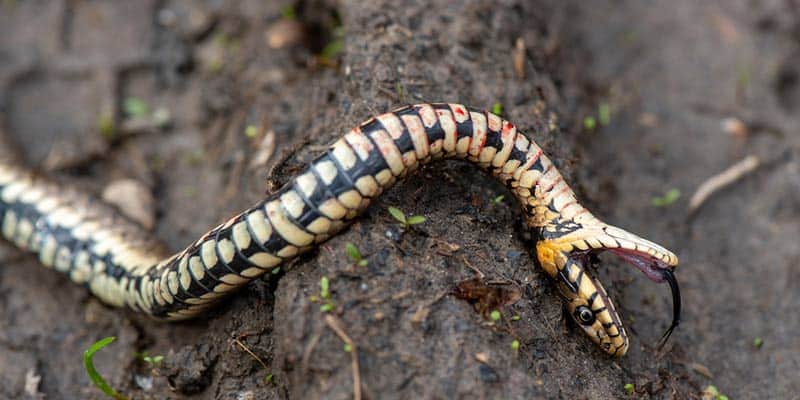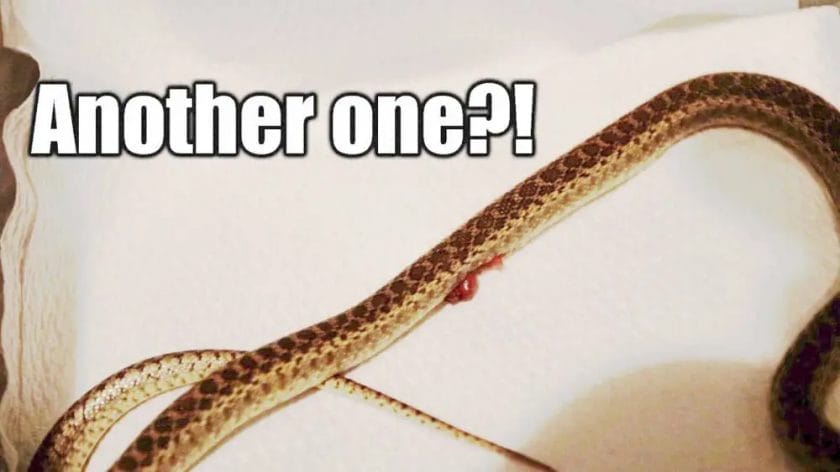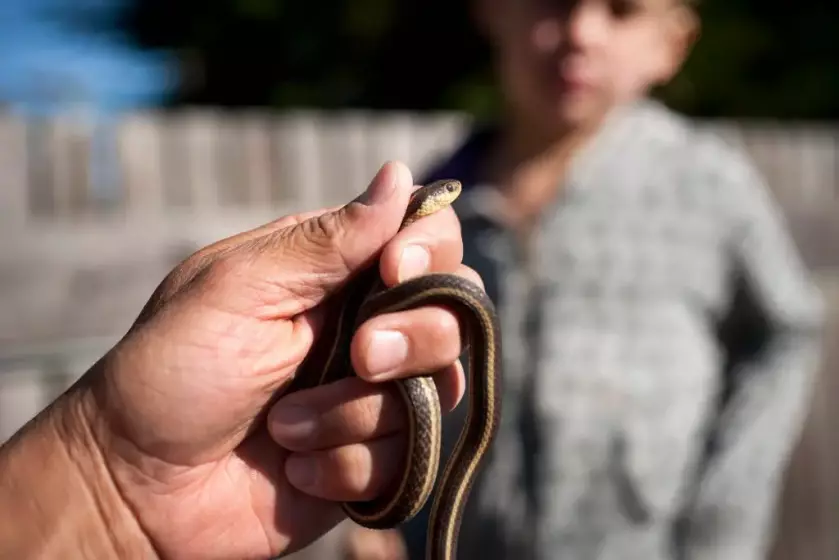When a snake sustains an injury, its chances of survival depend on various factors.
In many cases, snakes have remarkable regenerative abilities that enable them to heal from injuries.
However, the severity and location of the injury play a significant role in determining the snake’s chances of survival.
If the injury affects vital organs or causes extensive damage, the snake may struggle to recover.
Additionally, prompt medical intervention and proper care can greatly enhance the snake’s likelihood of survival.

Rehabilitation and Recovery: Nursing Injured Snakes Back to Health
Snakes are fascinating creatures that play an important role in the ecosystem. However, just like any other living being, they can suffer from injuries and illnesses. In such cases, it becomes necessary to rehabilitate and nurse these injured snakes back to health. This article will explore the process of rehabilitating and recovering injured snakes, highlighting the crucial role that nursing plays in their journey towards recovery.
1. Identifying and Assessing Injuries
The first step in nursing an injured snake back to health is to identify and assess its injuries. This requires a careful examination of the snake to determine the extent and nature of the injuries. Common snake injuries include cuts, wounds, fractures, infections, and internal organ damage.
Snake rehabilitation centers employ experienced veterinary professionals who specialize in reptile care. These experts use their knowledge and skills to perform a comprehensive assessment of the snake’s injuries. Diagnostic tools such as X-rays or ultrasounds may also be utilized to gain a deeper understanding of the snake’s condition.
2. Creating a Suitable Environment
Once the snake’s injuries have been identified and assessed, the next step is to create a suitable environment for its rehabilitation. This involves providing an enclosure that mimics the snake’s natural habitat while also addressing its specific needs for recovery.
The enclosure should be spacious enough for the snake to move around comfortably. It should also be equipped with the necessary temperature and humidity controls to ensure optimal conditions for healing. Additionally, the enclosure should be secure to prevent escape or further injury to the snake.
3. Providing Medical Treatment
Medical treatment plays a vital role in the rehabilitation and recovery of injured snakes. The exact treatment plan will depend on the nature and severity of the injuries. Common medical interventions for snakes may include wound cleaning and suturing, fracture stabilization, administration of antibiotics or antifungals, and pain management.
Administering medical treatment to snakes can be quite challenging due to their unique anatomy and physiology. Therefore, it is important for the nursing staff to have expertise in handling and treating reptiles. This ensures that the snake receives the necessary care without causing further harm or stress.
4. Nutritional Support and Rehabilitation Exercises
Proper nutrition is key to the recovery process of injured snakes. Nursing staff will design a suitable diet plan for the snake, taking into consideration its species, size, and specific dietary requirements. Snakes may be fed a variety of food items such as rodents, birds, or fish, depending on their natural feeding habits.
In addition to nutrition, rehabilitation exercises are crucial for snakes recovering from injuries. These exercises aim to restore the snake’s strength, flexibility, and overall mobility. Rehabilitation may involve gentle stretching, swimming, and climbing activities tailored to the snake’s abilities and comfort level.
5. Monitoring and Gradual Reintroduction to the Wild
Throughout the rehabilitation process, close monitoring of the snake’s progress is essential. Nursing staff will regularly assess the snake’s wounds, monitor its eating and elimination habits, and ensure its overall well-being. This allows any issues or complications to be addressed promptly.
Once the snake has made a significant recovery, a gradual reintroduction to the wild may be considered. This process involves carefully monitoring and releasing the snake into a suitable habitat. It is crucial to ensure that the snake is capable of hunting, navigating its environment, and thriving independently before being released.
Summary
Nursing injured snakes back to health requires a careful and comprehensive approach. From identifying and assessing injuries to providing medical treatment, nutritional support, and rehabilitation exercises, nursing staff play a crucial role in facilitating the recovery process. Through their expertise and dedication, they help injured snakes regain their health and ultimately reintegrate into their natural habitat.

Understanding the Impact of Injuries on Snake Survival
Snakes are fascinating creatures that have adapted to survive in diverse environments around the world. These reptiles play important roles in ecosystems and are often considered indicators of environmental health. However, like any other living organism, snakes are susceptible to injuries that can have a significant impact on their survival.
Injury Types: Snakes can experience a variety of injuries, ranging from minor wounds to severe trauma. Common types of injuries include bites, abrasions, fractures, and internal damage. These injuries can occur as a result of predator attacks, territorial disputes, accidental encounters with humans, or environmental hazards like extreme weather conditions or habitat destruction.
Immediate Effects: When a snake sustains an injury, it can experience various immediate effects that may affect its immediate survival. For instance, if a snake suffers a severe bite, it may lose a significant amount of blood, leading to hypovolemic shock and potentially death. Similarly, an injury to vital organs can compromise the snake’s ability to breathe, digest food, or regulate body temperature.
Long-Term Effects: Even if a snake manages to survive the initial injury, there can be long-term consequences that impact its overall survival. The presence of scars, deformities, or impaired functionality resulting from an injury can hinder a snake’s ability to move, hunt for prey, or evade predators. Additionally, injuries may weaken the immune system, making snakes more susceptible to infections and diseases.
Regeneration and Healing: Snakes have remarkable regenerative capabilities that allow them to heal from injuries. Shedding their skin periodically helps in the healing process by removing damaged tissue and promoting the growth of new cells. Additionally, snakes possess unique biological mechanisms that aid in the restoration of damaged tissues, such as specialized cells that facilitate wound closure and tissue regeneration.
Survival Strategies: In order to increase their chances of survival, injured snakes may employ various adaptive strategies. These strategies can include seeking shelter in protected areas, reducing activity levels to conserve energy, or altering their hunting behaviors to compensate for physical limitations. Some species of snakes have even been observed engaging in social behaviors, where healthier individuals assist injured members of their community.
Role of Humans: Human activities can have a significant impact on the survival of injured snakes. For instance, providing immediate medical attention and rehabilitation to injured snakes can increase their chances of recovery and release back into the wild. Additionally, conserving snake habitats, implementing measures to minimize human-wildlife conflicts, and raising awareness about the importance of snakes in ecosystems can contribute to the overall well-being and survival of these injured reptiles.
In summary, injuries can have a profound impact on snake survival. Understanding the types of injuries snakes can experience, their immediate and long-term effects, as well as their regenerative capabilities and adaptive strategies, allows us to appreciate the challenges they face in their natural habitats. By taking steps to minimize injuries and providing support for injured snakes, we can contribute to the conservation of these remarkable creatures and the ecosystems they inhabit.

Adapting to Life with Injuries: How Snakes Overcome Physical Challenges
Snakes are fascinating creatures that have the remarkable ability to adapt and overcome physical challenges. Despite their lack of limbs, snakes have developed unique strategies to navigate their environment and thrive even in the face of injuries. In this section, we will explore the various ways in which snakes overcome physical challenges and continue to survive and flourish.
1. Regeneration and Healing
One of the most astonishing abilities of snakes is their capability to regenerate and heal from injuries. When a snake loses a part of its body, such as a tail or a scale, it can regenerate the lost tissue and eventually regain full functionality. This remarkable process is made possible by the presence of specialized cells in the snake’s body that can differentiate and replace the damaged or missing tissue.
Furthermore, snakes possess an extraordinary self-healing ability. If a snake sustains an injury, it can produce a specialized protein called fibrinogen, which forms a clot and prevents excessive bleeding. The snake’s body then initiates a repair process, where new tissue is generated to heal the wound. This remarkable healing ability allows snakes to recover from injuries and continue their daily activities relatively unaffected.
2. Adaptations for Mobility
While snakes may lack limbs, they have developed unique adaptations to compensate for this limitation and move efficiently in their environment. One such adaptation is their flexible and elongated body shape. The absence of limbs allows snakes to maneuver through narrow spaces and navigate complex terrains that would be inaccessible to other animals. Snakes can slither and coil their bodies, making them highly adaptable and versatile in their movements.
Additionally, snakes have specialized scales on their belly called ventral scales, which aid in locomotion. These scales provide traction on various surfaces, allowing snakes to grip and push themselves forward. By utilizing their muscular body and ventral scales, snakes can move swiftly and silently, enabling them to hunt and escape from predators effectively.
3. Sensory Adaptations
Snakes possess remarkable sensory adaptations that help them compensate for physical challenges. One such adaptation is their ability to detect heat using specialized sensory organs called heat pits. These pits allow snakes to perceive infrared radiation emitted by warm-blooded prey, enabling them to locate and capture their meals with remarkable accuracy. This thermal sensing ability is particularly useful in low-light conditions or when the snake’s vision is impaired.
Snakes also rely heavily on their sense of smell to navigate their environment. They possess a highly developed Jacobson’s organ, which is located in the roof of their mouth. This organ detects and analyzes chemical particles in the air, providing snakes with valuable information about their surroundings, including the presence of potential threats or food sources. By utilizing their heat-sensing and olfactory abilities, snakes can compensate for physical challenges and maintain their survival.
4. Behavioral Adaptations
In addition to their physical adaptations, snakes exhibit various behavioral adaptations that help them overcome physical challenges. One such behavior is their ability to regulate their body temperature. Snakes are ectothermic animals, meaning they rely on external sources of heat to regulate their body temperature. By basking in the sun or seeking shade, snakes can maintain their body temperature within an optimal range, ensuring their physiological processes function efficiently.
Furthermore, snakes have the remarkable ability to adjust their feeding and hunting strategies based on their physical capabilities. For example, snakes with injuries that impact their ability to strike and capture prey may resort to alternative hunting methods, such as ambush predation. By adapting their hunting techniques, snakes can continue to acquire the necessary nutrients for survival despite physical challenges.
Summary
Snakes are remarkable creatures that have evolved ingenious ways to adapt and overcome physical challenges. Through regeneration and healing, snakes can recover from injuries and regain full functionality. Their unique body shape and scales enable them to move effectively in their environment, while their sensory adaptations allow them to compensate for physical limitations. Additionally, snakes exhibit behavioral adaptations that help them navigate their surroundings and acquire resources for survival. The resilience and adaptability of snakes serve as a testament to the incredible wonders of nature.
Factors Affecting the Survival Rate of Injured Snakes
When an injured snake is brought in for treatment, several factors come into play that can affect its chances of survival. Understanding these factors is crucial for veterinarians and wildlife rehabilitators in providing the best possible care and increasing the chances of successful rehabilitation and release back into the wild. In this section, we will explore the key factors that influence the survival rate of injured snakes.
1. Type and Severity of Injury
The type and severity of the snake’s injury play a significant role in determining its survival rate. Some common injuries observed in snakes include trauma from vehicle collisions, predatory attacks, venomous bites, and injuries caused by human activities. The extent of the injury, such as fractures, internal bleeding, or organ damage, can greatly impact the snake’s chances of survival.
In general, snakes with less severe injuries, such as minor fractures or superficial wounds, have a higher likelihood of survival compared to those with more severe injuries. However, the specific circumstances and the overall health of the snake also play a role in determining the outcome.
2. Species and Age of the Snake
The species and age of the injured snake can also influence its survival rate. Different snake species have varying abilities to recover from injuries and adapt to changes in their environment. Some species may be more resilient and have a higher survival rate, while others may be more susceptible to stress and have a lower chance of survival.
The age of the snake can also be a determining factor. Juvenile snakes, especially those that are still dependent on their parents, may have a lower survival rate compared to adult snakes. This is because young snakes are often more vulnerable and may require specialized care to ensure their survival.
3. Timely and Appropriate Medical Care
The timely provision of appropriate medical care significantly impacts the survival rate of injured snakes. When a snake is brought in for treatment, it is essential to conduct a thorough examination and diagnostic tests to assess the extent of the injury and determine the most suitable treatment plan.
In some cases, surgery may be required to repair fractures or remove foreign objects. Additionally, snakes may require supportive care, such as pain management, antibiotics to prevent infection, and fluid therapy to maintain hydration.
The expertise and experience of the veterinary team or wildlife rehabilitator also play a crucial role in ensuring the snake receives the best possible care. Knowledge of snake anatomy, physiology, and behavior is essential in providing appropriate and effective treatment.
4. Environmental Factors
The environment in which the injured snake is housed during its rehabilitation and recovery can significantly impact its chances of survival. Snakes require specific temperature and humidity levels to thrive. Providing an environment that closely mimics their natural habitat is essential for their overall well-being and successful rehabilitation.
In addition to temperature and humidity, the availability of appropriate hiding spots, suitable substrate, and access to clean water are also important. Stress levels should be minimized as much as possible, as stress can compromise the immune system and hinder the snake’s recovery process.
5. Post-Rehabilitation Support and Monitoring
The support and monitoring provided after the rehabilitation phase are crucial for a snake’s ultimate survival in the wild. This includes ensuring the snake is physically fit, adequately fed, and capable of hunting and defending itself before release.
Monitoring the snake’s behavior and health after release is also important to assess its ability to adapt to its natural environment. In some cases, snakes may require ongoing support, such as supplemental feeding or habitat modifications, to increase their chances of survival.
Summary
Factors affecting the survival rate of injured snakes include the type and severity of the injury, the species and age of the snake, timely and appropriate medical care, environmental factors during rehabilitation, and post-rehabilitation support and monitoring. Understanding and addressing these factors are crucial for wildlife rehabilitators and veterinarians in improving the chances of successful rehabilitation and release of injured snakes back into their natural habitats.
FAQs
Can an injured snake survive?
Yes, snakes have the ability to heal from injuries and can survive depending on the severity of the injury. However, the chances of survival will depend on various factors such as the type of injury, the snake species, and the availability of proper medical care.
Conclusion
In conclusion, the survival chances of an injured snake depend on several factors. While snakes possess impressive regenerative abilities, the severity and location of the injury play a significant role. Minor injuries, such as cuts or bruises, have a higher likelihood of healing and allowing the snake to resume a normal life. However, severe injuries, such as fractures or internal damage, can be life-threatening and reduce the chances of survival. Prompt medical intervention and proper care can greatly increase the snake’s chances of recovery. It is important to remember that injured snakes should be handled by professionals to ensure their safety and well-being.
